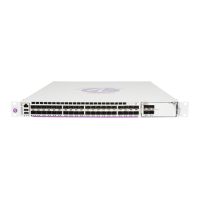Digital Diagnostics Monitoring
Page 32 7750 SR Interface Configuration Guide
Digital Diagnostics Monitoring
Some Alcatel-Lucent SFPs, XFPs, QSFPs, CFPs and the MSA DWDM transponder have Digital
Diagnostics Monitoring (DDM) capability where the transceiver module maintains information
about its working status in device registers including:
• Temperature
• Supply voltage
• Transmit (TX) bias current
• TX output power
• Received (RX) optical power
For the case of QSFP and CFPs, DDM Temperature and Supply voltage is available only at the
Module level (to be shown in Table 5.
The section called Statistics Collection on page 36 shows the following QSFP and CFP sample
DDM and DDM Lane information:
The QSFP and CFPs, the number of lanes is indicated by DDM attribute “Number of Lanes: 4”.
Subsequently, each lane threshold and measured values are shown per lane.
If a given lane entry is not supported by the given QSFP or CFP specific model, then it will be
shown as “-“ in the entry.
A sample QSFP and CFP lane information is provided below:
Transceiver Data
Transceiver Type : QSFP+
Model Number : 3HE06485AAAA01 ALU IPUIBMY3AA
TX Laser Wavelength: 1310 nm Diag Capable : yes
Number of Lanes : 4
Connector Code : LC Vendor OUI : e4:25:e9
Manufacture date : 2012/02/02 Media : Ethernet
Serial Number : 12050188
Part Number : DF40GELR411102A
Optical Compliance : 40GBASE-LR4
Link Length support: 10km for SMF
===============================================================================
Transceiver Digital Diagnostic Monitoring (DDM)
===============================================================================
Value High Alarm High Warn Low Warn Low Alarm
-------------------------------------------------------------------------------
Temperature (C) +35.6 +75.0 +70.0 +0.0 -5.0
Supply Voltage (V) 3.23 3.60 3.50 3.10 3.00
===============================================================================
===============================================================================
Transceiver Lane Digital Diagnostic Monitoring (DDM)
===============================================================================
High Alarm High Warn Low Warn Low Alarm
